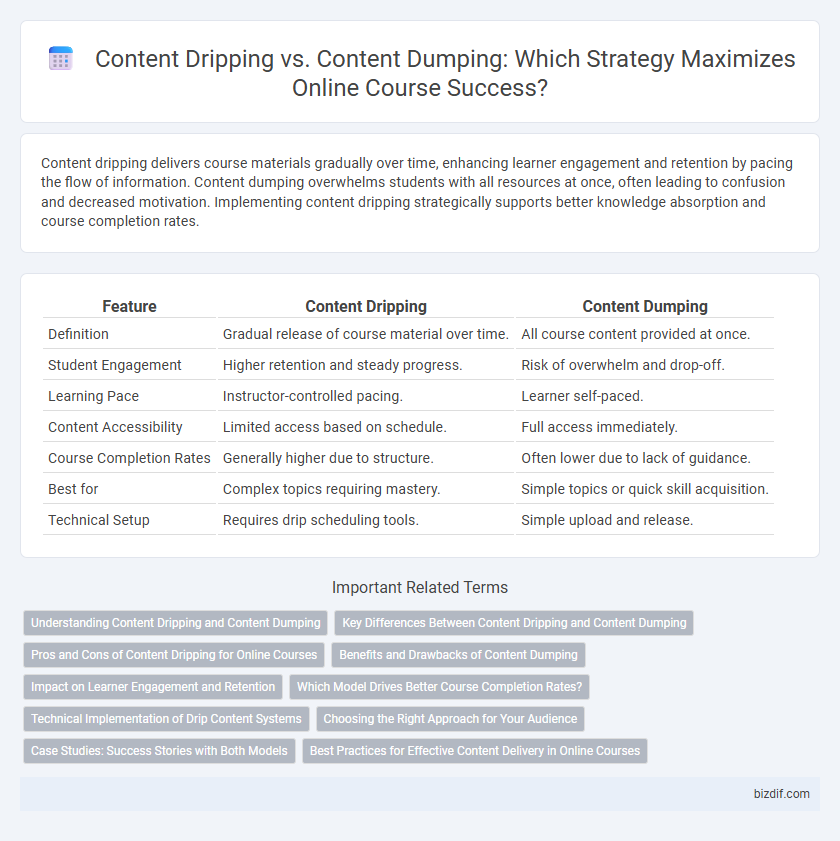Content dripping delivers course materials gradually over time, enhancing learner engagement and retention by pacing the flow of information. Content dumping overwhelms students with all resources at once, often leading to confusion and decreased motivation. Implementing content dripping strategically supports better knowledge absorption and course completion rates.
Table of Comparison
| Feature | Content Dripping | Content Dumping |
|---|---|---|
| Definition | Gradual release of course material over time. | All course content provided at once. |
| Student Engagement | Higher retention and steady progress. | Risk of overwhelm and drop-off. |
| Learning Pace | Instructor-controlled pacing. | Learner self-paced. |
| Content Accessibility | Limited access based on schedule. | Full access immediately. |
| Course Completion Rates | Generally higher due to structure. | Often lower due to lack of guidance. |
| Best for | Complex topics requiring mastery. | Simple topics or quick skill acquisition. |
| Technical Setup | Requires drip scheduling tools. | Simple upload and release. |
Understanding Content Dripping and Content Dumping
Content dripping refers to the strategic release of course materials in scheduled, manageable portions to enhance learner engagement and retention. Content dumping involves providing all course materials at once, which can overwhelm students and reduce motivation to progress systematically. Understanding the difference helps online educators design courses that foster consistent learning habits and improve overall course completion rates.
Key Differences Between Content Dripping and Content Dumping
Content dripping delivers course materials gradually over time, enhancing learner engagement and retention through scheduled releases of modules or lessons. Content dumping provides full access to all course content at once, allowing self-paced learning but risking overwhelm and reduced completion rates. The key difference lies in pacing control, with content dripping fostering structured progress while content dumping offers immediate, unrestricted access.
Pros and Cons of Content Dripping for Online Courses
Content dripping in online courses gradually releases material over time, promoting consistent learner engagement and reducing overwhelm by pacing the information flow. This approach enhances knowledge retention and encourages habit formation, but may frustrate students who prefer immediate access to all content or have variable learning schedules. While content dripping supports structured progression, it can limit flexibility and delay completion for self-paced learners seeking accelerated outcomes.
Benefits and Drawbacks of Content Dumping
Content dumping involves releasing all course materials at once, enabling learners to progress at their own pace and access resources immediately. This approach benefits self-motivated students who prefer flexibility but can overwhelm others, leading to decreased engagement and completion rates. Without structured guidance, content dumping may hinder consistent learning habits and reduce instructor-student interaction.
Impact on Learner Engagement and Retention
Content dripping strategically releases course material over time, boosting learner engagement by maintaining a steady flow of new information and allowing time for knowledge absorption. In contrast, content dumping overwhelms learners with excessive information at once, leading to decreased retention and reduced motivation. Consistent content delivery enhances long-term learning outcomes and improves course completion rates.
Which Model Drives Better Course Completion Rates?
Content dripping delivers course materials in scheduled segments, fostering consistent learner engagement and higher completion rates compared to content dumping, which releases all information at once. Studies show that drip-fed courses can increase completion rates by up to 40% due to improved pacing and reduced overwhelm. Learners benefit from gradual content absorption, leading to better retention and course satisfaction.
Technical Implementation of Drip Content Systems
Content dripping involves scheduled release of online course modules using automated Learning Management System (LMS) features, allowing timed access based on enrollment date or user progress. Content dumping delivers all course material immediately, often via bulk file uploads or mass content publishing without access controls. Drip content systems require backend scheduling algorithms, user progress tracking, and dynamic content gating to enhance learner engagement and retention.
Choosing the Right Approach for Your Audience
Content dripping delivers course materials gradually, improving retention by pacing learning and maintaining engagement over time, whereas content dumping provides all resources upfront, catering to self-paced learners who prefer immediate access. Analyzing your audience's preferences, learning styles, and motivation levels is crucial for selecting the optimal method. Choosing between these strategies ensures higher completion rates and better learner satisfaction tailored to your course demographics.
Case Studies: Success Stories with Both Models
Case studies reveal that content dripping fosters higher learner engagement and course completion rates by delivering material in manageable segments over time. Conversely, content dumping suits self-paced learners who prefer immediate access to all resources, resulting in faster knowledge acquisition but sometimes lower retention. Successful online courses integrate both models by combining structured content release with flexible access, maximizing user satisfaction and learning outcomes.
Best Practices for Effective Content Delivery in Online Courses
Content dripping involves releasing course materials gradually over a set schedule, enhancing learner engagement and retention by preventing information overload. Content dumping floods learners with all materials at once, often leading to overwhelm and decreased course completion rates. Best practices for effective content delivery prioritize structured pacing, timely assessments, and consistent interaction to optimize learner progression and satisfaction.
Content Dripping vs Content Dumping Infographic

 bizdif.com
bizdif.com